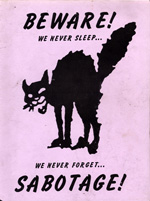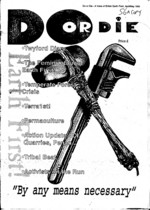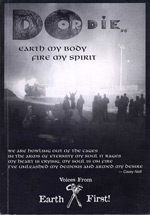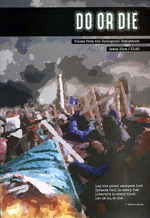Do or Die was a monumental achievement of internal communication for the radical environmental movement. Self critical, smart-assed, and information dense- there is no better source material for this era of wilderness defense.
Anti-Roads
The Black Cat Sabotage Handbook
The Black Cat Sabotage Handbook, 3rd edition (1996, Eugene, OR.)
When I was a kid the world didn’t have the sort of instant gratification now expected for all transactions, and thank goodness. You can really appreciate the value of something more once you’ve clipped five proof of purchases, put them into an envelope, mailed them away, and waited 6 to 8 weeks for your Zartan action figure to arrive. Distribution for the Black Cat Sabotage book worked the same way – you clipped an ad out of a zine and mailed it in along with concealed cash. A few months later a copy showed up in a nondescript envelope. I still remember when mine was delivered…
My first copy of Black Cat left me feeling like I was involved in some sort of conspiracy just turning the pages. Sure, most of it was reprints that I had already seen before, but the layout, the graphics, and the text all seemed to carry the message that action was urgent and that the enemy was watching. (Of course, we were all sending envelopes with our return addresses to the same damn PO Box in Eugene, so if anyone was watching they already knew who we were!) At the time I didn’t know who was publishing or distributing it, but rumors eventually surfaced in the mid 2000’s that the book was compiled by Bill Rogers, an accused Earth Liberation Front member who took his own life behind bars in 2005. In his suicide note he said that his death was a “Jail break,” and as he slowly suffocated himself with a plastic bag he gripped one hand into a fist, and with the other, extended his middle finger.
I only met Bill one or two times and did not get to know him well, but since his death I have heard many complicated things about him. From what I gather he was at times heroic, but had some serious, perhaps unforgivable flaws that should not be ignored. In that respect he is like the book that he was rumored to have clipped together and sent out anonymously. The Black Cat Sabotage Handbook contains some good bits of information, some serious inspiration, and some decent arguments for the use of sabotage and even violence. Likewise, it also contains some foolhardy nonsense that could get someone jailed or killed for little positive gain. The cover shouts, “BEWARE!” and smart readers will heed that advice.
In closing, here is to Bill. He was a man I can best respect by keeping off a pedestal. I can not deny that many of the stories about him are disconcerting, but I also can not deny the beauty of his attempts to spark a revolution against industrialism. As his friends sat shivering and complaining in a car, it was Bill who trekked alone through snow, uphill and burdened with the weight of gallons of fuel to set a fire that would announce to millions the existence of the Earth Liberation Front. That speaks volumes about his fighting spirit, and his wild drive to right the wrongs our species has perpetrated. His death saddens me, but something tells me that someone so intent on freeing others would not have done well spending decades behind bars- perhaps in that sense his “jail break” really was a form of escape. He will be remembered as a warrior.
 |
Copse
Copse (1998, Kate Evans, Chippenham, England.)
“The direct action campaign against road building in Britain is the most successful revolutionary movement in Western Europe in the Second half of the 20th Century. Never before in this period have such radical aims been so comprehensively achieved in so short a time. Never before has a central component of government policy, to which billions of pounds had already been committed reversed, without the need of a change of government, by citizen politics. The humble, impoverished people who fought and won this war have plenty to be proud of.” -George Monbiot, from the introduction.
Sometimes a social ill can become so prevalent that it is sewn into the fabric of our society, normal in all senses, and so common that invisibility is reached. So it is with the car. Whether fueled by gasoline or electricity, bio-diesel or hydrogen, the automobile is one of the most destructive things on earth. Cars emit more than half the world’s air pollution, and kill more animals every year than the fur and vivisection industries combined. But that is only the beginning of the problem. You see, cars require roads, and they travel on them at deadly speeds. What this means is that the streets– a commons where people once gathered– are no longer a place to live and interact, but a place to pass through. The automobile has completely altered our social structure and harmed the ability of normal people to meet and share their discontent with the existing order. Roads now take up more than 1/3rd of most cities, and when parking, garages, gas stations, and other things necessary to feed and house cars are taken into consideration, more than half of our urban space is dedicated to traveling metal boxes. This is an ecological and social catastrophe that goes largely ignored even amongst those who care about human community, wilderness, and non-human animals.
But, it wasn’t always this way. Less than 20 years ago thousands of people fought against the building of new roads in England and elsewhere, and the actions which they undertook are greatly inspiring. From complex villages of tree sits and blockading devices to mass daylight arsons, the anti-roads movement was tremendously successful in preventing the furtherance of car culture and its corollary social and environmental impact.
There were many attempts at documenting this exciting people’s struggle, but none of them were quite as fun as Kate Evans’ Copse. Comprised of interviews, photographs, essays, and plenty of comics, Copse distilled the spirit of the protests onto each page. Part history lesson, part graphic novel, this book is a great starting place to understanding an important piece of the recent history of mass direct action.











